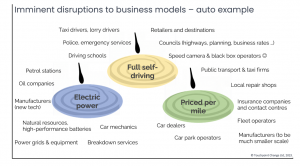Every Leader should have an AI Vision to set direction and an AI Strategy to guide the practical next steps. This will lead an organisation to exploit the productivity improvements of AI. The team will then move on to think about new products, features and services for their customers. Adopting AI will help us think through the limitless opportunities, but more important may be the risks.
Beyond that, AI will collide with the very core of our businesses, often in surprising ways. That is the focus of this article.
To go straight to an example, changes in the automotive market in the 2020s will be profound. The ripples of three simultaneous trends will combine to overwhelm many existing businesses. They are already spawning multi-billion dollar start-ups, ready to sweep away the incumbents.

1.First of all, we have the move to electric vehicles.
This is proving a real challenge for established automakers with only Tesla and certain large Chinese firms seemingly able to compete on features and value. The traditional manufacturers are struggling to keep up as they not only have to design the advanced new technology but also migrate to the next generation of manufacturing and supply chain processes. Just at a time that their debt is high and cashflows are drying up from declining internal combustion engine sales.
Beyond that there’s a big disruption for natural resource companies and miners as different minerals are needed to produce the high-performance batteries. The Chinese seem to have stolen the market, buying up supply chains with more vision than their competitors. However, new deposits are now being found and large mineral-rich countries will be key players.
With the move to plug-ins, there is an obvious impact on power grids with fast chargers requiring enormous amounts of energy in places where enormous amounts of energy were not previously required. There is a game of chicken and egg between the users of electric vehicles and the power distribution companies. It is a conundrum that neither wants to get ahead of the other but neither wants to be behind either.
There are other sectors of the economy which will be disrupted by e-vehicles. Obviously fuel stations and retailers, but also independent local mechanics who have different expertise and different tooling. They will be locked out of some elements of servicing due to warranty requirements and skill gaps. Less servicing will be required as electric vehicles have 95% fewer moving parts.
2.Beyond that, the second disruption is hard on its heels. Full self-driving cars will change our habits significantly.
A range of AI technologies is behind this revolution. Tesla is leading the charge but every major manufacturer is desperately trying to forge ahead. Self-driving taxis are running in several cities across the world, and it is inevitable that all cities will follow. Some of the first people to be put out of business will be taxi drivers and lorry drivers. You can imagine these workers being made redundant at the rate the vehicles come off the production line. The business case for the operators is too strong to ignore.
Other sectors impacted will include black-box makers and driving schools, as the next generation of young people simply doesn’t need to learn. Speed camera operators will thankfully see a decline in revenue and police and emergency services should see fewer accidents.
Self-driving cars will start to change our retail and leisure habits, the initial rumblings of a third disruption we’ll look at shortly. For instance, I tend to avoid town centres with their traffic jams, expensive car parks and slow travel. But in future, my self-driving car could drop me off and then go and park itself somewhere cheap so I might use town centres more often. This will change retail patterns. Councils will find that revenues from business rates will change, as will the needs of infrastructure.
3.On the back of this, a third disruption is incoming. The price-per-mile car.
Customers will not need to spend thousands of pounds upfront to purchase a vehicle, or even sign up to an expensive PCP rental. They will simply summon the right type of vehicle via their phone whenever they need it. Robo cars will become the norm. When I go to work I will choose a small vehicle with a small desk to work at. If I am taking a settee to the dump I will summon a minivan. When taking my family out, I will select an MPV. Every journey in the most appropriate vehicle for less than the current cost of a taxi or even a personal car. Only delivery drivers and travelling reps with huge annual mileages will find it cost effective to purchase their own vehicle. Town centre car park operators will be out of business and public transport will be under pressure as convenient door-to-door travel will be the norm.
Vehicles will be manufactured by the tens of thousands for the big fleet operators. Insurance companies will issue one insurance certificate for a 10,000-vehicle fleet instead of 10,000 different policies for 10,000 different people. The customer service needs will be minimal, and will be served as part of the scheduling AI in the apps. Makers of contact centre equipment will see revenues reduce.
The low level of private ownership will also mean the utilisation of vehicles is much higher. Instead of a personal car being sat on a driveway or in a car park for 80% of the time, a much smaller number of cars will be busy for 80% of the time, optimised by AI algorithms. This implies big opportunities for fleet operators but much smaller volumes for the auto manufacturers. This may well be the death knell for the local engineering repair shops as the new cars will simply drive themselves to an industrial-scale servicing centre for their infrequent servicing. Roadside assistance will not be needed as a replacement vehicle will arrive in minutes.
The combined ripples from these three changes will create a tidal wave that will engulf many businesses over the next 5 to 10 years.
There is a much bigger picture too. The kind of AI behind self-driving electric pool cars is just one of dozens of types of AI which are being developed, in dozens of sectors.
The author Kevin Kelly stated that, there isn’t a single business process that won’t benefit from being made more intelligent. That will raise opportunities for brand new businesses to spring up while established businesses that cling on to their models for slightly too long may drown.
It will be an exciting world, but a devastating one for any business swept away in the currents. As the management guru W.E.Deming said, “Survival is optional. No one has to change.”
It is vital that every leader has an AI vision and an AI strategy, both for the short term and the long term. We must all know what three waves are going to engulf us over the coming years and how we can be prepared.
Only by keeping up with these changes and constantly thinking through the implications will we serve our customers well and thrive in the future.
Let’s make sure your business strategy properly considers the incoming wave of AI!
STAY UP TO DATE
Sign up to our monthly newsletter The Pulse to stay up to date on all things S&S . Or follow us on LinkedIn and Twitter to stay up to date about all things transformation.





































































